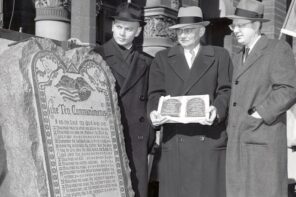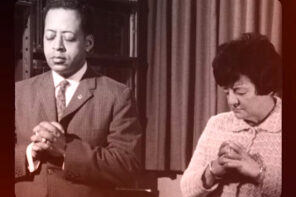Back in April, Wired magazine published a story on the history of a strange monument in rural Elberton, Georgia (“granite capital of the world”) known as the Georgia Guidestones. The monument consists of four 16-foot-high slabs of granite arranged around a central column and topped with a capstone weighing 25,000 pounds. Carved onto the face of each slab is a list of ten precepts for creating a better society, written in eight modern languages. On the four sides of the capstone are written the words, “Let These Be Guidestones to An Age of Reason” in Sanskrit, Babylonian cuneiform, Classical Greek, and Egyptian hieroglyphs. The central column and capstone are also equipped with holes, astronomically aligned so that the Guidestones can serve as a compass and clock.
The popular consensus is that these stones were meant to survive a global apocalypse and aid survivors in creating a new, enlightened society. Unveiled in 1980, and built by an unknown party, the monument has stood for nearly thirty years outside of town, attracting the curious to Elberton. However, in the last ten years the Guidestones have garnered the attention of conspiracy theorists, who see their message as anti-Christian and a call for a global government. This new reading of the Guidestones ultimately led vandals to deface the monument sometime in December 2008.
The official story of the Guidestones’ origin is that Joe Fendley Sr., president of the Elberton Finishing Company, was contacted in 1979 by one “Robert C. Christian” to commission a monument. Christian was a pseudonym used by someone representing “a small group of loyal Americans who believe in God.” Fendley has since died, but Randall Sullivan of Wired interviewed Wyatt Martin, the president of Granite City Bank and the only living man who allegedly met Christian. As the project’s banker, Martin allegedly learned Christian’s true name but will not reveal it. Martin claims he received letters and phone calls from Christian until “around the time of the 9/11 terrorist attacks” and assumes Christian is dead; though some believe Christian never existed. While construction was still underway, Martin and Fendley were accused of perpetuating a hoax, either out of amusement or to promote Fendley’s business. Both men took lie detector tests, which they passed. Sullivan suggests that the hoax rumor may have come from rival granite workers.
According to Jim Miles (author of Weird Georgia), shortly after the Guidestones were unveiled, a local minister stated his suspicion that “Mr. Christian is not a Christian” and that the monument was designed for the worship of the sun as well as the devil. Contemporary Pagans, UFO buffs, and New Agers were naturally attracted by the mystery of the site. New myths were created that the monument was built upon a “power-nexus” or a place sacred to Native Americans. One legend holds that visitors who point both arms at the monument (one palm up, one palm down) will receive a psychic message from the stones. Another Guidestone admirer, Yoko Ono, composed a three-movement score entitled “Georgia Stone.”
In 2000, Dr. Reagan R. Davis, a Christian minister, visited the stones and concluded that the Guidestones may well describe the ten commandments of the Antichrist. Particularly upsetting were the precepts to “Maintain humanity under 500 million in perpetual balance with nature,” “Guide reproduction wisely encouraging fitness and diversity,” and “Let all nations rule internally, resolving external disputes in a world court.” Davis interpreted these messages as a call for a world government, a policy of state-sponsored eugenics, and the culling of billions of people. This new interpretation elevated the Guidestones from mere local curiosity to the subject of national notoriety among conspiracy theorists and Christian dispensationalists.
Conspiracy buffs were quick to point out the similarities between the pseudonym “R.C. Christian” and Christian Rosenkreuz, the legendary founder of the esoteric Rosicrucian Order. (Documents attributed to Rosenkreuz were signed “Frater C.R.C.”). Christians added that The Age of Reason is also the title of a book by Thomas Paine, which challenges the inerrancy of the Bible. Through numerous Web sites and talk radio programs, a narrative eventually emerged in which the Guidestones (along with ancient esoteric societies like the Masons, eugenics, perceived anti-Christian hostility, and globalization) were all part of a single monolithic entity known as the “New World Order.”
The goal of the New World Order is the creation of a single world government and the destruction of national sovereignty and religion. A significant number of Christian dispensationalists subscribe to this view and believe that the New World Order was foretold in the Book of Revelation. In 2005, Mark Dice (using the pseudonym “John Connor” in reference to the Terminator film franchise) organized a Christian group opposed to the New World Order called “The Resistance” and began a campaign to have the monument destroyed. In 2007, radio personality and filmmaker Alex Jones released a documentary entitled Endgame: Blueprint for Global Enslavement, outlining a plan by the Bilderberg group and other global elites to exterminate eighty percent of humanity. The Georgia Guidestones are cited as primary evidence of this plot.
The call of The Resistance was eventually answered with an attack on the stones by vandals who used a can of red spray-paint to write messages such as, “The elite want 80% of us dead,” “9-11 inside job,” “Obama iz a Muslim,” and “Council on Foreign Relations is ran by the Devil.” The stones were also splashed with polyurethane, which is especially difficult to remove. The vandalism has been celebrated on numerous Web sites discussing the New World Order’s agenda; with only a few dissenting voices pointing out that any assault on free speech, even the free speech of an anonymous cabal, threatens the rights of all. The vandalism of the Guidestones seems to be a classic case of an eccentric and lofty idea under assault by the hoi polloi. In fact, a letter from the monument’s benefactors printed by the Elberton Granite Finishing Company predicted just such a scenario. They ask that the people of Elberton County restore the stones should they be “scattered by people of little understanding.”
The short history of the Guidestones has parallels with the history of other mysterious messages and prophesies. It seems plausible that whoever invented the name “R. C. Christian”—be this an actual cabal or Fendley and Martin—had some knowledge of Rosicrucianism. (Fendley was active in the local Shrine Club where he could have been exposed to Rosicrucian lore.) There are interesting similarities between the Guidestones and the origin of the Rosicrucian legend.
A European preoccupation with the mysterious Rosicrucian order began in Germany with the appearance of two anonymous documents in the early 17th century: Fama Fraternitatis and Confessio Fraternitatis. Clearly someone wrote these documents although, much like the Guidestones, there is little evidence to determine whether these messages were a legitimate manifesto from a secret brotherhood or an elaborate hoax. But regardless of their origin, the excitement generated in the wake of anonymous messages is very real. Numerous modern esoteric groups claim a connection to the Rosicrucians just as conspiracy theorists regard the Guidestones as vital evidence of a demonic globalist agenda.
Another interesting parallel can be drawn between the Guidestones and the Book of Revelation. Both are texts of little-known origin warning of future peril. These conditions allow for historical-critical as well as dispensationalist readings of both messages. Scholars believe the Book of Revelation was written sometime in the first century and is a warning to early Christians not to conform to the evils of Greco-Roman society. Although the Guidestones were constructed relatively recently, they too have a historical context. The letter from the Guidestones’ benefactors describes the problem of global overpopulation and warns that, “Armageddon can be prevented.”
Whoever planned the monument in 1979 most likely imagined that Armageddon would take the form of nuclear war with the Soviet Union. “R.C. Christian” could not possibly have predicted the events referenced by the vandals, such as the attacks of September 11 or the election of Barack Obama. But Dice, and others like him, read the Guidestones much as they read the Book of Revelation: not as historical artifacts but as important clues to understanding current events. Stripping the messages of their historical contexts allows them to converge, so that they mutually confirm a dualistic cosmology in which Christians must battle the New World Order. Thus, evidence of the New World Order’s unfolding plot can be found both in the Book of Revelation and in the Georgia Guidestones. Likewise, Dice’s use of the pseudonym “John Connor” is very telling. Like the character in Terminator, he likely sees himself as one who knows the future and is fighting to prevent it from happening.
The history of the Guidestones is ultimately an interesting study in the heterogeneous nature of symbols. To build something so extraordinary with so little explanation created a vacuum of meaning. Much like the Guidestones’ inspiration, Stonehenge, this caused new meanings to be invented. The Guidestones are essentially a spiritual and political Rorschach test onto which any number of ideas can be imposed. Pagans and New Agers created new myths and rituals, imbuing the stones with sacred reverence. For others, the monument is not the marker of a sacred space but the evidence of a demonic plot. Should the Guidestones survive for centuries as their creators intended, many more meanings could arise, equally unrelated to the designer’s original intention.




